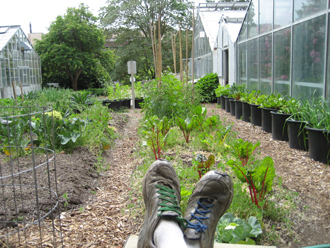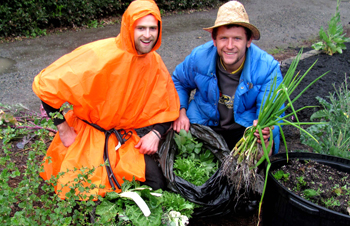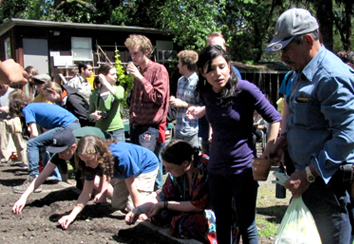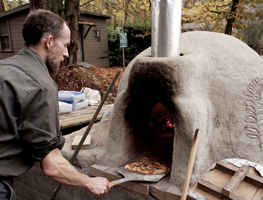Brady Ryan knows how to get down and dirty.

As outgoing student director of the UW Farm, Ryan has spent many an afternoon digging in the dirt between the Botany Greenhouse and the Burke-Gillman Trail, where the University’s farm is located. He’s among a growing number of students—about 30 a week at last count—who volunteer their time at the farm.
“It’s given so much orientation to my life,” says Ryan, who graduated in June with a BA in mathematics. “Whatever else I do, I know that growing food will be a thread in my life.”
A group of faculty, staff, and students founded the UW Farm in 2004 as a way to teach students about the impact of our food choices and to demonstrate the possibilities of urban farming. Currently, about 70 crops are grown on the farm’s one-third acre plot, thanks to creative use of limited space.
“Cities are full of marginal spaces, where weeds are growing,” says Beth Wheat, education director for the farm and one of its founders. “Campus has a term for this: unmaintained space. That’s where the farm is located.”
Despite its small size, the farm’s impact has been considerable, with a growing number of UW courses using it as a learning tool.

Wheat, a graduate student in biology, developed the first course specifically designed with the farm in mind. Aptly named Urban Farm (Biology 240), the course covers farming principles such as crop rotation, pollination, irrigation, and composting, as well as larger questions of food production and planetary sustainability. Hands-on work at the farm, or another urban farm in Seattle, is a course requirement.
Ryan took Wheat’s class the first time it was offered and was hooked immediately. Since then, he figures he has spent about 20 hours a week working the farm and coordinating other volunteers’ time there. He also has taken nearly a dozen courses related to food, in departments from anthropology to biology to geography to history.
“My focus these last two years has been how we feed ourselves as a species,” says Ryan. “One of the really interesting, motivating questions for me is whether we can, with sustainable food systems, feed the world. The farm has been a touchpoint for all the courses I’ve taken related to this. It’s been a grounding point.”
Ann Anagnost, professor of anthropology, shares Ryan’s fascination with global food issues. Several years ago, she began offering Anthropology of Food, a course that explores cultural and economic aspects of food, alternative food communities, and more.

"Food sovereignty is an important concept in food politics today," says Anagnost. "One aspect of food sovereignty is to grow your own, at least in part. This requires learning skills that almost everyone used to know but we now have lost."
Anagnost's class tours the UW Farm, with some students volunteering regularly. "Students see their peers teaching themselves and others how to produce their own food," says Anagnost. "They see that the student farmers not only get great joy from doing so but also create a sense of meaningful community around the production and sharing of food. I believe this is an important life lesson no matter what career path they may follow in the future."
Also tapping into the farm is Devon Peña, professor of anthropology and American Ethnic Studies. Several students had asked for his help in increasing diversity among farm volunteers. “I thought, ‘Maybe we need to begin with crop diversity, which will then lead to other diversity,’” recalls Peña. He redesigned his agroecology course, requiring students to devote half their time to a project for the farm. The most visible result is the addition of a traditional Mexican kitchen garden—a milpa popular—to the farm. Peña and a student’s family donated their own saved seeds of corn, beans, squash, aromatics, and chiles for the milpa, and the class collaborated with the Latino student group MEChA to maintain the new garden. The class also planted traditionally harvested native plants of the Northwest, with Skokomish elder John Miller blessing the space
Many students discover the UW Farm through courses like Peña’s. But Nina Arlein, who replaces Ryan as the farm’s student director, learned about the farm before enrolling at the UW. In fact, it was one of the things that attracted her to the University. After arriving on campus, she dove right in, attending a farm meeting during her first week as a Husky. The next quarter, she became a farm intern, developing her own project.

“Like Brady, I feel the farm is the place where I can shape and combine a lot of my interests,” says Arlein, a comparative history of ideas major. “I’m excited to devote so much time to it. I factor that into my schedule. The farm is the best part of my school day.”
That sort of dedication is critical, says Wheat, given the complexity of running a student farm. “The difference between a student farm that’s successful and one that fails is a director who basically lives there,” says Wheat.
Of course no one student can sustain a farm without community support. The UW Farm has that in…well, spades. There’s the Dirty Dozen, a core group of students who meet weekly to set farm priorities and schedule volunteer hours. A weekly farm lunch seminar attracts more students, who hear from UW faculty and urban farmers on a range of food-related topics from growing fruit trees to creating a certified organic farm. The farm also organizes student tours of local urban farms, from Seattle to Olympia to the San Juan Islands.

The farm’s most visible community event may be the monthly Cob Oven Pizza Bake, which brings the farm community and other interested parties together to socialize. The event features pizzas baked in an adobe-like cob oven, built on site in 2007. The oven’s design allows food to cook slowly using just a small amount of wood. Each academic quarter ends with a pizza bake fundraiser, complete with farm updates, tours, and live music.
Arlein invites anyone curious about the farm to attend the pizza bake—or just help work the farm some afternoon. “At this University, it’s easy to get lost,” says Arlein. “I’ve found the farm to be a great place to find a community of people. The pure joy of being there…it’s just special.”
For more about the UW Farm, visit the farm’s website at students.washington.edu/uwfarm.
To read about Farm Education Director Beth Wheat's Excellence in Teaching Award, click here.
More Stories

What the Sky Teaches Us
Brittany Kamai, an astrophysicist with knowledge of Pacific Islanders' Indigenous navigation using the sky, is teaching a new UW course, Pacific Indigenous Astrophysics.

Two Majors, Complementary Skills
Elizabeth Xiong (2024), a double major in art history and computer science, shares how she gained different and complementary skills from each major.

Exploring Connections Through Global Literary Studies
The UW's new Global Literary Studies major encourages students to explore literary traditions from around the globe and all eras of human history.